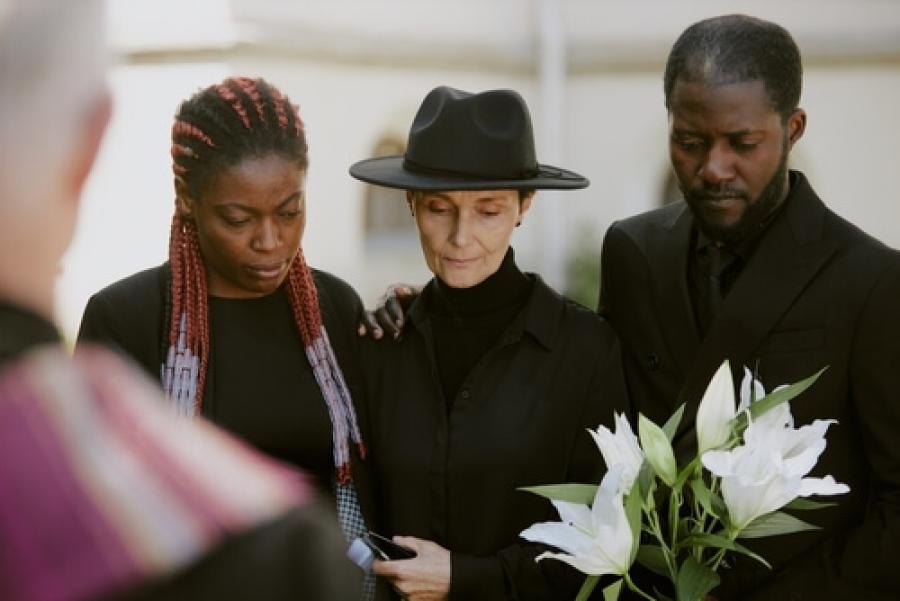
Colours of bereavement: tradition and meaning in different cultures
When we think about how to dress for a funeral, we should be aware of the colours of bereavement in different cultures and religions in order to show empathy to the family who has lost a loved one. In this article, we delve into the different traditions and the importance of colours when a loved one passes away.
Colours of bereavement in different cultures
Colours take on a symbolic value that enable us to express grief or sadness when a person passes away. But there are many ways of interpreting this symbolism around the world. What are the colours of mourning in different cultures?

Black as a colour of mourning in the West
In most Western countries, the colour of bereavement is black. Not surprisingly, it is also the main colour of mourning in Spain.
However, nowadays there is a little more leniency in the sense that other dark colours are also used as a sign of mourning after the passing of a loved one.
Furthermore, in certain specific situations, the colour of mourning may vary. For example, if the deceased is a minor, the colour white becomes the protagonist, as it is a symbol of purity.
White as a colour of mourning in Asia
In many Asian countries, the colour of mourning is white, although the reasons for adopting this colour are different in each region.
-
The colour of mourning in China is white because it symbolises the paleness of death.
-
The colour of mourning in India is white because it contrasts with the skin colour of most Indian citizens.
-
White is the colour of mourning in Japan because it symbolises purity.
In fact, this last reason is the most widespread among Asian countries for adopting white as the colour of mourning. This is why family members wear white at their funeral ceremonies when a loved one passes away.
Other colours of bereavement around the world: red, yellow and purple
Not all countries choose neutral mourning colours. Around the world there are numerous customs in this regard. For example:
-
In Mexico and Syria the colour of mourning is sky blue, as this is the place where people who pass away are believed to go.
-
In South Africa the colour of mourning is red, the same colour as the blood of the deceased.
-
In Thailand they wear purple as a sign of mourning, a colour that is also linked to mourning in Christianity. We will look at this later.
-
Orange is the colour of mourning in Egypt because it expresses hope and spiritual renewal. It is also the colour of the setting sun, which is a metaphor for the end of life.
With the clothes we wear at a funeral, we need to send the right message when paying our respects and condolences to the family of the departed. For this reason it is so important to know the traditions of each country when it comes to the colours of bereavement.
Colours of bereavement in different religions
There are not only differences in the colours of mourning for geographical or cultural reasons. The passing of time and the evolution of traditions or religion are also key factors in this respect. Let's take a look at the traditions of some of the different religions.
Colours of mourning in Christianity
In Spain, it was the Catholic Monarchs who in 1502 established that the colour black was the most appropriate colour to show grief for the death of a loved one.
However, although it may seem to be a custom that originated in Christianity, the truth is that Judaism adopted it earlier. In the Jewish tradition, the custom was to sprinkle the face of the deceased person with black powder or ashes, as it was believed that, by doing so, death would not be able to recognise them and would not be able to take them away.
Another colour of mourning in Christianity is purple. This is the liturgical colour associated with penitence and reflection, as well as spirituality and connection with the divine.

Colours of mourning in Buddhism
In Buddhism, mourning is expressed through yellow robes. Mourners use this colour because for them it signifies neutrality and good luck, and because it represents freedom from worldly citizens.
However, the colour white is also very common in Eastern Buddhist areas (Japan, China, India, for example), as we have already seen, because it acquires a very specific symbolism, as white means ‘to come and go from emptiness’.
Colours of mourning in Islam
The colour of mourning in Islam is white. That is why it is also the colour of mourning in Morocco, where, in addition to this colour, the traditions of the Qur'an dictate that relatives are forbidden to wear ostentatious clothing or jewellery when a loved one dies.
There are three days of mourning after death with the exception of widows, who must wear white for at least 40 days as a sign of bereavement. They must mourn their husbands for four months and ten days, a period known as Iddah. Once that time has elapsed, women can wear jewellery again or even move to a bigger house or remarry.


